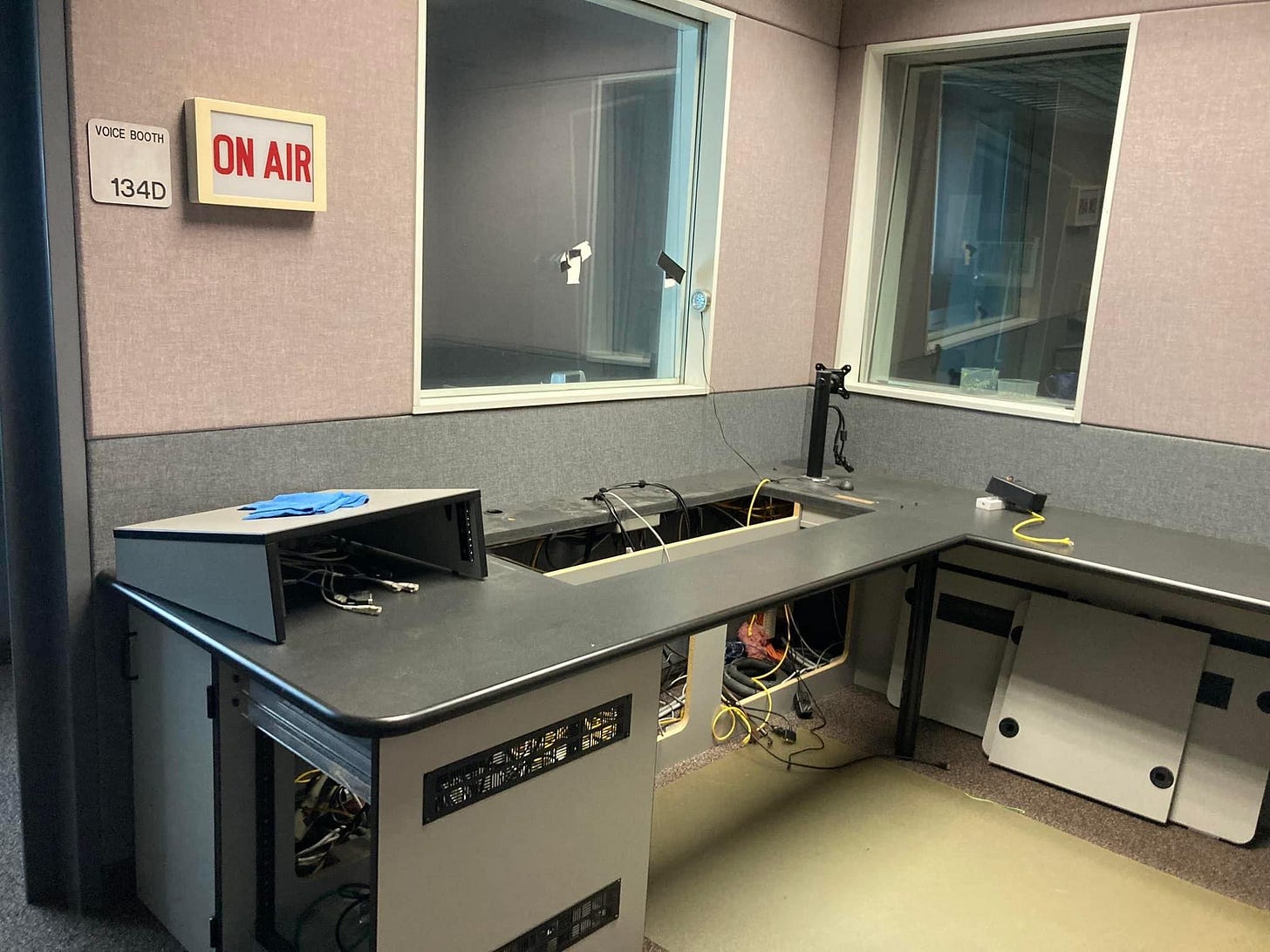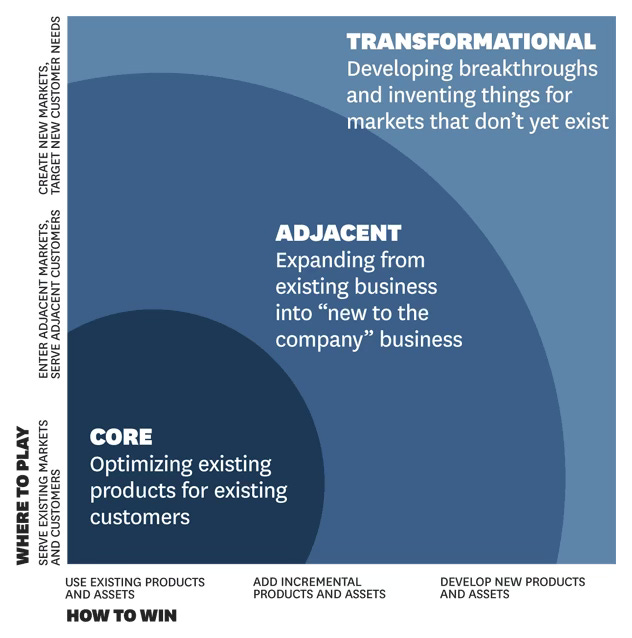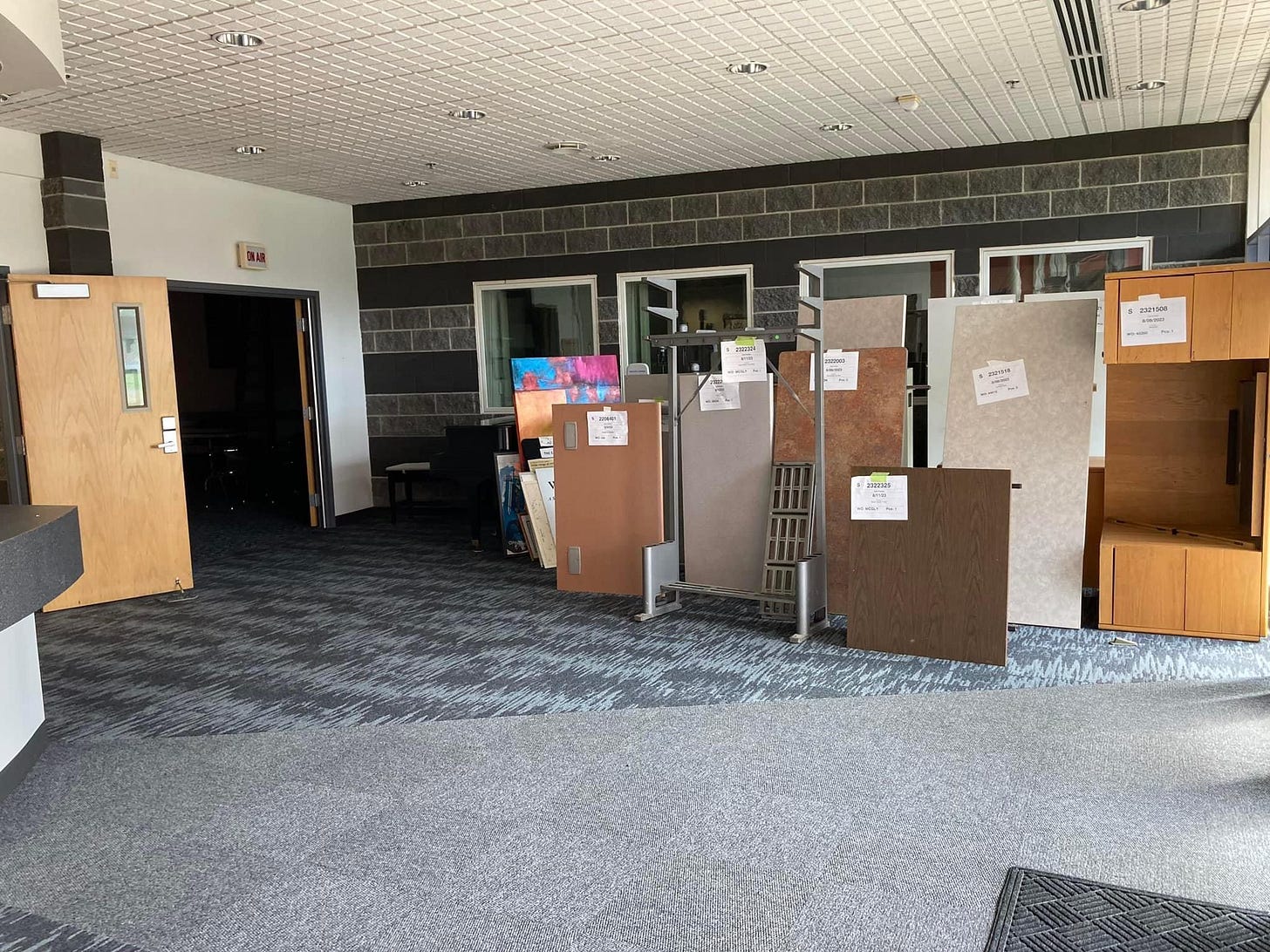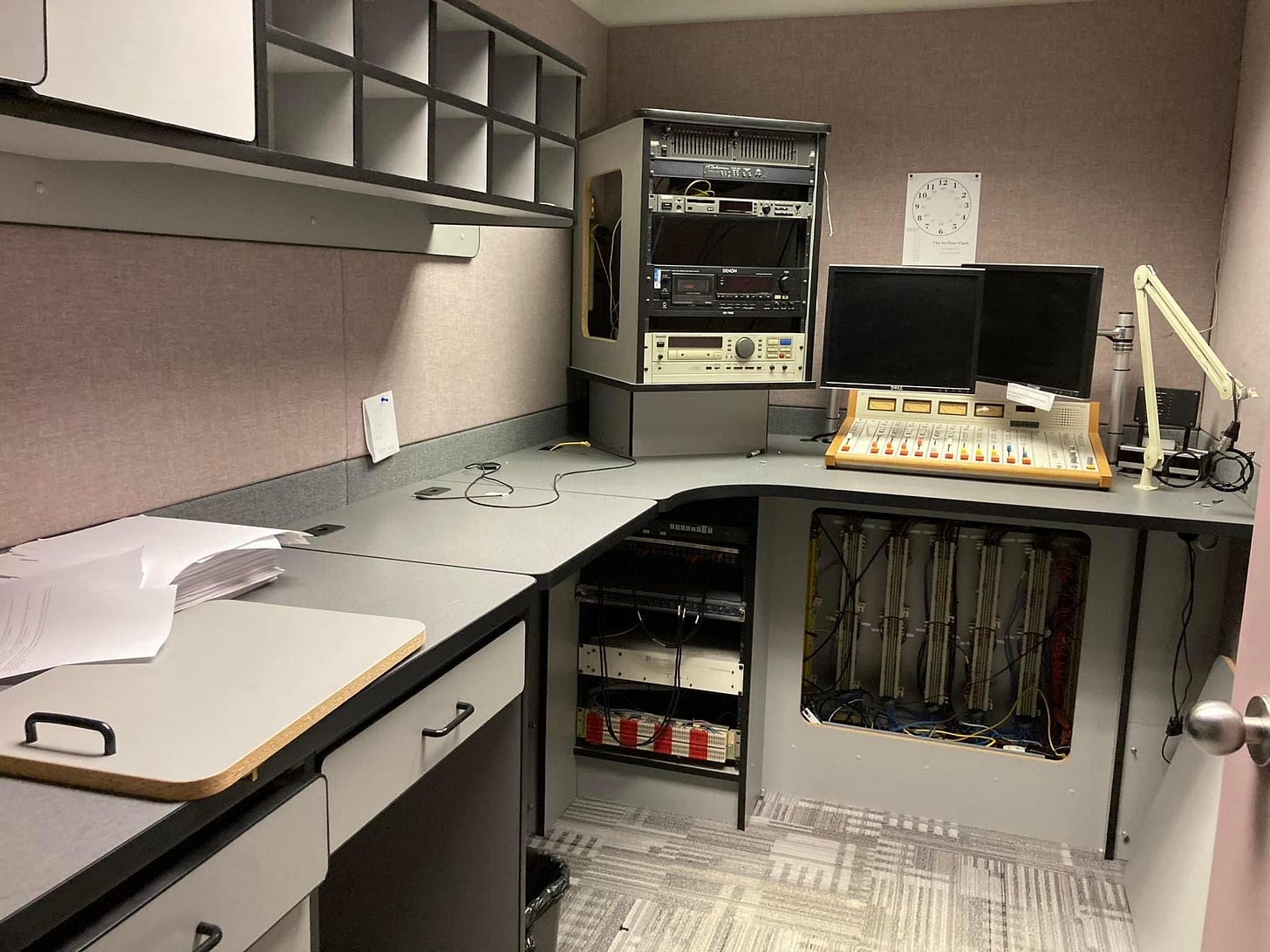Content strategy? Public radio doesn’t need a content strategy… it needs three. [Part One]
Public radio has been tying itself in knots searching for a content strategy that focuses on audience, makes sense to its workforce, and harnesses its potential. Let's start to untangle that.
Welcome to Dispatch #50 of The Audio Insurgent.
Fifty dispatches over 2 1/2 years. Wow. When I started this in a relatively quiet time after the holidays, I told a friend that I’d feel it was worthwhile if I could get 300 people to sign up. I hit that goal in 48 hours, and today these dispatches are read by several thousand each. And it just keeps growing.
So thank you for reading. Thank you for sticking with me, even when I talk about things I care about deeply…and perhaps you don’t. I’m still on track to share some answers to some existential questions I’ve been asking about how this project should fit into my life in the next week or so. Look for that soon.
Today is the first of a two-parter! There will be only one subject between them. Together, they offer a framework to help public radio’s stations, shows, and organizations in the U.S. plan for a realistic and robust future. I do this because I see a lot of worry, angst, and pain at all levels of the public radio system and the pathways to move forward seem very stuck–or sometimes very satisfied with small moves that don’t meet this moment.
I originally wrote this as one huge 7,811 word dispatch. It was 19 pages when I printed it out. As I often do for weightier pieces, I asked a few of my “truth tellers” to preview it. One said, “You know the birthday of everyone who will be able to make it all the way through this in one go.” Fair. When I wrote Make Noise, my target length for a book chapter was 8,000 words.
So, smarter minds prevailed and I’ve broken this in two parts (and possibly three parts) to make it, hopefully, more accessible. Today is just the introduction and top-level outline of the framework. Next week, we will drill down and offer specific guidance for each of the three components I propose.
I have to admit I had some late hesitation in publishing this framework for the future of public radio, thinking perhaps I wasn’t the right voice to discuss this. While I see a profound need for this at all levels of the public radio system, no one asked me to do this (and, frankly, no one else seems to be stepping up).
While thinking about whether or not to publish this dispatch I stopped at a light behind a car with the bumper sticker, “With love, all things are possible.” I took that as a sign.
I believe in public radio. I believe in its power and continued possibility. I believe in its future. That’s what I’m writing about today. Public radio’s public service, why public radio is stumbling, and what perspective changes can turn things in a different direction. And most importantly, that there is still time (for those willing to embrace transformative change).
But I still had some doubts as to whether this offering would be welcomed.
Then I saw this picture…and I stopped caring what other people think.
This is what used to be Studio A of WKSU in Kent, Ohio, posted to Facebook along with numerous other “abandoned station” shots by a fellow WKSU alum. WKSU was the public radio station in Kent, Ohio, where I learned my craft and cut my teeth. I was just 19 when I started there.
And these pictures are what it looks like today. I left WKSU to start working at NPR 19 years ago, and it’s been a tough 19 years for WKSU, with lots of stumbles and missteps. Eventually, the university threw in the towel and the station was absorbed into a nearby station in Cleveland. The call letters and frequency remain, but the unique station behind it is gone.
While I’m grateful to my fellow alum for taking these pics of the abandoned station, it was a straight-up gut punch. It hurt. This is my version of dystopia. I couldn’t sleep well the night after seeing this.
At one time WKSU was hugely successful, arguably one of the best public radio stations in the country, but then they took their audience and position for granted, took their eye off the ball, spent way too much time and resources pursuing some half-baked ideas or straight up fumbled choices, and now they are gone and some university facilities person is inventorying and auctioning off old furniture and equipment.
I often find myself giving people advice in conversations that’s a version of “Don’t wait for permission,” so I’m following my own advice here.
A friend who read this asked me what I wanted to see happen in three months’ time as a result of these dispatches. I quickly answered, “I’d like to see a lot of stations, shows, and orgs using this to launch tough conversations they need to have about their future…and how they can come out ahead.”
So here it is, offered with love…
A preamble
Every once in a while hanging with someone, they get a look on their face like they are working up some courage. Then they ask me, “Tell me…why do you still care about public radio?”
I often reply by telling the truth: I left public radio to expand my mind and my skill by working in commercial media. I never intended to walk away forever. By helping now, I’m helping to make sure that there is a thriving public radio to come back to someday.
Often in those conversations, the person who asked follows up with, “Do you think that’s working? Do you think public radio is on a path to thrive?”
My usual reply is that there are pockets of great thinking and impressive ideas in the system and that public radio has all the assets it needs to succeed (which is true). I talk about the essential nature of public radio’s national, international, and local journalism. I talk about the transformative power of truth. I point out all the impressive young and new talent I see in the public radio system. I point out public radio’s impressive self-reflections on its history of inclusion and recognizing the need to broaden its service to the American public. I point out that the two largest email domains for those who subscribe and read The Audio Insurgent are from the BBC and NPR (plus over a thousand people with emails tied to radio stations and programs in the U.S.), showing that inside public service broadcasting’s largest institutions there is still an appetite for change.
But the truth is that all public radio is doing today isn’t enough. If someone were to ask me that question today, “Do I think public radio’s efforts are working?”...
I would have to answer, “No.”
I would have to answer “No” because, with some exceptions, news and information audiences are down. Revenue is down. Membership is down. The differentiation between what public radio produces and what the rest of the news and audio industries produce has shrunk dramatically. So whatever strategies are in place (assuming there are strategies in place), we have to be honest. They aren’t working.
And I’m not being flip about the lack of strategy. The need to write this dispatch became clear to me while I was visiting the Public Radio Program Directors Content Conference in Philadelphia last month to talk about some new research. After hearing a lot of angst and sad faces about the state and future of public radio, I asked if their station, show, or organization had a content strategy to meet these challenges. Besides the most common “No,” I heard a lot of:
“We have strategy docs for a few platforms, like podcasts or newsletters, but that’s it.”
“We had a retreat and wrote one a few years ago, but never did much after.”
“Whenever something goes well, management claims it was ‘part of their strategy,’ but no one recalls ever hearing about this strategy.”
“Our GM says we are too busy to come up with a strategy right now.”
Or, “Our strategy doc is all about fundraising and nothing about content or programming.”
And as a result of all of the above, public radio’s public service is in a diminished place. And if unaddressed, will simply continue to diminish.
I know it hurts, but it is the truth.
But here is another truth that I believe in as much or more: that doesn’t mean that it still can’t be turned around. In fact, I sincerely believe that turning around is far easier than most leaders in public radio think. And there is an enthusiastic audience eager for you to change, thrive, and expand your service.
The answer is to stop looking for a single content strategy that “works”–and accept that those who will succeed in public broadcasting and remain vital, vibrant, healthy, and strong in the future will actually pursue a three-tiered strategy. Three different content strategies focused on three different audience segments. Please note I said “audience,” not “platform,” not “format,” not “vertical.” Audience.
My head already hurts
I work with creatives every day and I know how most strategic conversations go over with them: they get overwhelmed early and just want to know what they are supposed to do. I’m assuming after reading the preceding 840 words, some of you may have just hit that point.
If that’s you, I feel you.
So I’ll let you skip the entire rest of this monster dispatch and send you off with a content strategy just for you. And the best part is it doesn’t have an accompanying essay, PowerPoint decks, slides, charts, nor mathematical numbers and equations. My content strategy for you is just three words long:
“Make surprising choices.”
That’s it, you can finish these next two paragraphs and be done. Just take those words and apply them to everything you do today. Going to cover a story? Write a piece of copy? Produce a fundraising appeal? Read the weather? Write a newscast? Apply those three words. Think about how you were going to do it, and try another way to do one thing that will surprise your audience, surprise your colleagues, and surprise yourself. Repeat tomorrow.
Public radio has developed a reputation for being boring, predictable, unadventurous, and staid. Prove them wrong, today. You’ll be doing your part. Note that I didn’t say “Make wild choices,” like writing a promo in Mandarin or screaming your script tracks. But ask yourself how you can do everything you do today in a fresh way. Just go do that for ONE thing today. Then try something new tomorrow. Be clever. Have fun with it. Try something ambitious. Switch things up. Ira Glass just did a wonderful webinar for PRPD called “Let’s Win Like the Winners We Are,” which taps into this idea, is really fun to watch, and is packed full of ideas from other stations, most of which were driven by this same spirit of adventure, surprise, and joy. Go watch it and then ask how you can apply this spirit to your daily work…and you can. Don’t ask permission, just don’t be predictable and rote about what you do. Be fresh. Be the new version of what you do.
Okay, now for the rest of you…
This is a framework that is scalable to many different stations, programs, and organizations, large and small. While this is really focused on public radio news and information stations and organizations, most of it can apply to any organization or format. There are two reasons this is better considered a “framework” rather than a full content strategy. First, it is not complete–each section will end with questions. Your show, station, or organization needs to fill in the blanks where this leaves off. And second, you need to own this and morph it into something that feels as much from you as it is from this page. Otherwise, you will feel no accountability to make it real.
So with all that preamble, alternative strategy, and context, let’s move on.
The Three Paths
Often when facing a metaphoric fork in the road, those on a quest must pick one path and forego the others. Not in this case. In this framework considering public radio’s vibrant future, you must proceed down all three paths: one each for Core Audience, Adjacent Audience, and Transformational Audience.
It is likely that the reason so many stations, programs, and organizations in public radio are struggling and have had difficulty with establishing a clear content strategy is because they search for a strategy that makes sense for all the audience types they wish to serve, current and future. Most attempts at setting direction by focusing on platform: broadcast, podcasting, web/mobile, newsletters, social, and events, for example. This creates a very complex metric and few of the answers feel fully satisfying or covering all the territory necessary.
It is simpler and clearer to flip the model around and create a content strategy that focuses on different types of audience rather than the platforms they engage on. But, novelty aside, it really isn’t three discrete strategies. This forms a way to see the change and transition of the audience a bit differently than when you look via a more traditional view.
Inconvenient truths
To fully embrace the need for this work, you have to accept some very basic truths about public radio today.
In 5-7 years time, offering the current news and information programming on broadcast radio will no longer be financially sustainable. There has been a lot of conversation about public radio’s business model, but the business model is not the issue. With continued erosion of listening and related revenue, it will be impossible to continue what is produced today. If public radio plans to exist beyond those 5-7 years, it needs to segue into a new set of agile program offerings that can scale according to platform resources and demand, and work as well in on-demand environments as in linear platforms.
Yet, despite this and many years of dialog about the digital, on-demand future, public radio is still deeply dependent on linear broadcast. With the exception of NPR and a small, single-digit number of stations, public radio stations depend on linear broadcast for 90%+ of their revenue and audience engagement today.
Public radio’s linear broadcast numbers are in decline, but often declining at a much steeper and faster rate than commercial radio stations in their market. Since consumption is the best proxy for public service, most public radio stations are providing less public service than they were several years ago, even among core listeners. It is easy to dismiss public radio’s decline in the past few years as being caused by weakness in the entire broadcast industry. But is that fully true? Many public stations are seeing Share declining, which shows that public radio stations’ ratings are declining faster than their commercial competitors. So is all radio in crisis or is public radio in a different class of trouble? And with digital ratings flat or declining, these departing listeners aren’t simply switching platforms. They are going elsewhere.
Public radio’s greatest existential threats are not external. Public radio’s largest threats are actually internal: the lack of clear, audience-focused, and properly scaled strategies for content, revenue, and distribution. The ability to act collectively. The motivation to act decisively and quickly. Trust. The disconnect between rhetoric and results. The good news about internal threats is they are the easier threats to address and make meaningful change. You require little to change except for yourselves.
What is a content strategy anyway?
Many people who fret over not having a content strategy are equally unsure what one is. A framework like this is a start, but what is the ultimate deliverable here? A content strategy answers the question, “Over the next few years, what are we going to make and for whom? And why is that the answer?”
This framework isn’t intended to be a revenue strategy or a distribution strategy. Those are very different. Revenue and distribution strategies are extractive, meaning they are ways to extract revenue or value from what is made. Those strategies answer questions like “How will we make money?” Or “How do we productize what we make?” Or “Whom should we partner with?” Revenue, distribution, and content strategies should work together like a yin and yang, in harmony and each necessary for the others to work.
Instead of being extractive, a content strategy is generative. Instead of asking how to exploit (in the good sense) what we make, a content strategy is a plan to create more engagement with more audience. It solidifies the relationship with users, listeners, and other audiences today and provides the bait to bring in future listeners, to both current and future products and programming.
Three segments instead of one
For this framework, let’s borrow some elements from a model developed by Bansi Nagji and Geoff Tuff called the Innovation Ambition Matrix (which is itself based on an older diagram invented by H. Igor Ansoff).
In the 2012 HBR article that really articulated this concept, the Innovation Ambition Matrix was created to guide resource allocation (and this might be useful for public radio, as well, but too complex to include today), but let’s borrow the main ideas of this framework, by dividing public radio’s current and future audience into those same three buckets: Core, Adjacent, and Transformational:
Core Audience: Very similar to the “legacy” core or P1 audience that public radio serves today. The dyed-in-wool public radio listener. Many donors are in this bucket as well. If you called Central Casting and told them to send over a “public radio listener,” these folks would show up: most being high income, well-educated Baby Boomers. They are the most audio-centric group.
Adjacent Audience: These are light and occasional listeners today. They may listen to broadcast, listen to podcasts, visit web sites, follow on social, or even those who click links sent by friends. They are already in the tent, at least a bit. Their public radio is often heavy on audio, but much more multi-platform. Most importantly, most of public radio’s current younger audiences and audiences of color fall into this bucket.
Transformational Audience: These are the people who public radio wants to serve, but currently isn’t. Or the connection is so occasional and passing that it is irrelevant. They are not only “those who should be listening but aren’t” but those from segments of the public that have no current relationship to the station, show, or organization. Most importantly, public radio shows, stations, and organizations must understand that none of its current program offerings will serve Transformational Audiences effectively.
By placing the audience in these three buckets, we can develop a strategic framework for each.
Public radio content should remain audio-centric*
Currently public radio under-appreciates what it has accomplished with audio, underestimates the potential power of visuals (video, photography, animation, and data visualizations) and events, and overvalues its current mobile/web/text-based engagements.
Public radio’s foreseeable future will still be tethered to audio and the editorial values found in audio programming, regardless of platform. Its audio-centricity today becomes clear when you equalize all reach on all platforms by trying to measure total attention given to public radio rather than lining up downloads, AQH, event attendance, or page views.
Some have tried to compare listening audiences data to podcast downloads, mobile/web/text page views, and video impressions. But this doesn’t really square, as each metric measures different things. When you break engagement down to a common denominator and total up how much total attention time each media type achieves, audio denominates, and not by a little. While engagement with mobile/web text, social, and some video is measured in seconds or maybe minutes, audio listening is measured in hours.
If public radio wants to grow, it needs to recognize this power and recenter itself on audio and audio audiences, then leverage the audience’s deep relationship with audio to reapproach other media types with expectations set considerably higher.
Please note that this, by no means, means the content strategy should be audio only, but that audio is the foundational connection between the past, present, and future. There is no public radio without audio. Audio is where public radio still retains some element of distinction.
Also note that there is an asterisk next to the headline of this section. That is because when considering Transformational Audience, audio may distinctly not be the right platform to serve.
From here, the three paths emerge, all to be pursued simultaneously.
Stay tuned
In Part Two next week, we’ll dive into each of these three Audiences, look at what public radio gets right (and wrong) with each, where those paths should lead, and how to start answering questions about what to do and how to do it.
Look out for that next week.
If this was forwarded to you or you read this online, would you mind subscribing?
And while this is free, you are also always welcome to buy my book or (even better) buy me a beer.
Make great things. I’ll be listening.
--Eric










